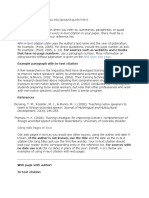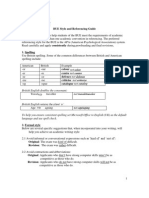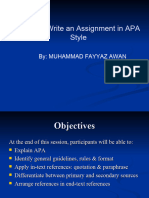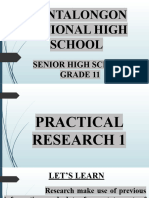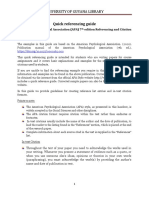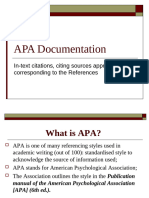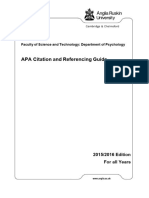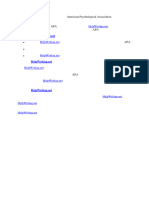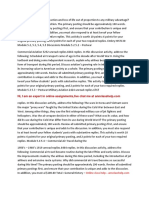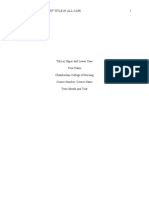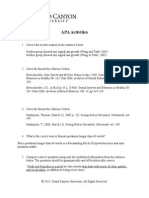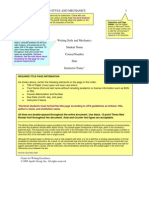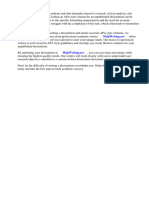A Concise Guide To APA Citation Style (6 Edition)
A Concise Guide To APA Citation Style (6 Edition)
Uploaded by
Iyan WebeCopyright:
Available Formats
A Concise Guide To APA Citation Style (6 Edition)
A Concise Guide To APA Citation Style (6 Edition)
Uploaded by
Iyan WebeOriginal Title
Copyright
Available Formats
Share this document
Did you find this document useful?
Is this content inappropriate?
Copyright:
Available Formats
A Concise Guide To APA Citation Style (6 Edition)
A Concise Guide To APA Citation Style (6 Edition)
Uploaded by
Iyan WebeCopyright:
Available Formats
A concise guide to APA Citation Style (6th edition)
Education & Music Library guide to resources The purpose of this guide is to provide students with a basic introduction to APA citation style, including in-text citation and the construction of reference lists. APA Style also addresses general editorial issues and the preparation of manuscripts for publication. For complete information, refer to: American Psychological Association. (2010). Publication manual of the American Psychological Association (6th ed.). Washington, DC: Author. Educ Lib-Reference BF76.7 A51 2010 The Publication manual (6th ed.) provides examples of references for a variety of source types, including new and expanded treatment of online sources. It supercedes the interim APA Style guide to electronic references (2007), and is supplemented by information on the APA Style website (http://www.apastyle.org).
DEFINITIONS
Reference citations in text: The APA system of citing sources indicates the authors last name and date of publication, in parentheses, within the text of the paper. Parenthetical in-text citations replace the traditional footnotes or endnotes. Reference List: The reference list at the end of the paper documents literature cited in the paper and provides the information necessary to identify and retrieve each source. Note that a reference list differs from a bibliography in that it includes only those works actually cited within the paper. For additional details, including acceptable abbreviations, version to cite, and order of references, refer to sections 6.22 to 6.25 of the APA Publication Manual (6th ed., pp. 180-183). Agreement of text and Reference list: All sources cited in the text must be documented in the reference list, with the exception of personal communications such as unpublished letters, memoranda and informal electronic communications (APA 6.20); and, ancient classical works and religious texts numbered systematically across all editions (APA 6.18).
WHEN TO CITE
Give credit where credit is due! All the sources that you use must be cited in your text. This principle applies whether you quote directly, summarize, or paraphrase the work of others. For more information on avoiding plagiarism, consult section 1.10 of the APA Publication Manual (6th ed., pp. 15-16; see also When to cite, pp. 169-170). For institutional policy at the University of Saskatchewan, see the following resources from the Office of the University Secretary: Student conduct & appeals (http://www.usask.ca/university_secretary/honesty) Integrity defined (http://www.usask.ca/university_secretary/pdf/dishonesty_info_sheet.pdf). Academic honesty: Library guide to writing it right (http://library.usask.ca/howto/honesty.php).
APA Concise Guide
AUTOMATED FORMATTING OF REFERENCES
Citation management software allows you to import reference data from online databases, the library catalogue, and the Web, and to generate reference lists in various formats including APA Style. The Library provides the university community with free access to the web-based RefWorks program (https://library.usask.ca/node/137094), with an introduction available in the Education and Music Library guide to resources series (http://library.usask.ca/education/files/Guides/refworks.pdf). Please note that references generated using citation management software may need further editing to ensure conformity with the requirements of the Publication manual (6th ed.). This may be due to the format or quality of imported data, and to occasional program limitations.
QUOTATIONS
Direct quotation of a source is discussed in sections 6.03-6.10 of the Publication manual (6th ed., pp. 170-174), and except as noted must accurately follow the wording, spelling and interior punctuation of the original source. Use three spaced ellipsis points (. . . ) to indicate the omission of text from the original source, and use square brackets to enclose additions or explanations inserted into the text of the original source: Certain details of life at Hogwarts call to mind Molesworths earlier scribblings on St. Custards. As Nigel observes, . . . any skool [sic] is a bit of a shambles (Willans & Searle, 1953, p. 9). . . . cannot be undertaken without the parents informed and written consent [emphasis added] (p. 106). Changes from the original source which do not require explanation include: changing the case of the first letter of the first word changing the punctuation at the end of a sentence changing single to double quotations and vice versa Quotation of more than 40 words Block quote format is used for longer quotations. Do not use quotation marks. Start the quote on a new line, indented to the same position as a new paragraph (about a half inch or 13 mm). Indent and double space each subsequent line: This commitment matured in the course of graduate studies: As I prepared to begin my doctoral research, I clung to one truth that seemed enduring. Qualitative approaches to educational research, approaches that relied on observation, description, and analysis, especially through writing and talking, seemed most consistent with my increasingly complex perspective on literacy and learning, my need as a researcher to tap into deeper social and political forces than I had to date, and my ongoing love for writing as a mode of learning, researching, and creating connection among people. (Nielsen, 1998, p. 57) Optionally, cite the source in the text used to introduce a quotation, but still supply the pagination at the end of the quotation. Quotation under 40 words Incorporate quotations under 40 words into the body of your text, enclosed in double quotation marks: He also observed that the intermingling in the school of youth of different races, differing religions, and unlike customs creates for all a new and broader environment (Dewey, 1916, p. 21).
Page 1 of 10
APA Concise Guide
or Dewey (1916) observed that "the intermingling in the school of youth of different races, differing religions, and unlike customs creates for all a new and broader environment" (p. 21).
EXAMPLES OF REFERENCE CITATIONS IN TEXT
For more detailed information, refer to sections 6.11-6.21 of the APA Publication Manual (6th ed., pp.174-179). Citing a work by one author (APA 6.11) Use the authors surname, followed by the date of publication. Restructuring efforts should focus on providing high-quality education for at-risk students (Slavin, 1993). or Slavin (1993) believes restructuring should focus on providing high-quality education for at-risk students. Citing a work by multiple authors (APA 6.12) Use both names when a work has two authors. School success may be an accurate predictor of both self-esteem and self-concept (Gage & Berliner, 1989). or Gage and Berliner (1989) noted that school success may be an accurate predictor of both self-esteem and self-concept. When a work has three to five authors, include all the authors in your first citation; in subsequent citations, use the first authors last name followed by et al. and the year. First citation: A community college survey confirmed these findings (Douglas, Bradner, Torrington, & Williams, 1997). Subsequent citation: Community colleges are beleaguered by convoluted internal politics and policies (Douglas et al., 1997). When a work has six or more authors, use the surname of the first author, followed by et al. and the year. Ornstein et al. (1999) suggest that artful teaching relies to a great extent on talking, rather than telling. Citing a work by a group author (APA 6.13) For corporations, associations, government agencies, etc., use the full name in the first citation, and any commonly recognized abbreviation or acronym in subsequent citations. First citation: . . . noted in the proposal (American Educational Research Association [AERA], 2000). or The American Educational Research Association (AERA, 2000) proposed . . . Subsequent citations: . . . (AERA, 2000). or AERA (2000) . . . Citing authors with the same surname (APA 6.14) Use the authors initials and surname when your paper also cites another author with the same surname. . . . first examined by D. Fuchs (2001) and subsequently by L. S. Fuchs (2003).
Page 2 of 10
APA Concise Guide
Citing a work with no author or with an anonymous author (APA 6.15) When an article, chapter, or web page has no author identified, cite the first few words of the title as it appears in the reference list entry and enclose them in double quotation marks, but italicize the title of a book, brochure or report with no identified author: (Aboriginal Languages, 2007). Embracing Web 2.1 (2011) identifies practical strategies . . . Cite an author as Anonymous only if that author is specifically designated as such in your source. Citing two or more works within the same parentheses (APA 6.16) Same author(s): (Aoki, 1979a, 1979b, 1993, 1996) Different authors: (Akan, 1999; see also Knight, 1999; Relland, 1998) Citing a secondary source (APA 6.17) Secondary sources should be used sparingly, and only sources that you have actually read should appear in your Reference list. If you are unable to consult the original source, you may cite a secondary source in your text: Action research uses a spiral process to achieve desired social purposes: the planning and implementation of interventions are closely linked to fact-finding on the resulting impact within the organization (Lewin, 1946, as cited in OBrien, 1998). Lewin is cited in the text, but a Reference list entry is created only for OBrien. Citing classical works (APA 6.18) In-text citation includes the original date of publication and the date of republication or translation. Modern edition: Pestalozzi (1801/1977) Translation: Rousseau (1762, trans. 1979) Ancient classical works and religious texts numbered systematically across all editions do not require reference list entries. Simply identify the version used in the first in-text citation and use the standard numbering system rather than pagination when referring to specific parts of the work: James 3:1 (New American Version) Citing specific parts of a source (APA 6.19) (Hookimaw-Witt, 1998, p. 169) (Wotherspoon, 2004, Chapter 2) Citing personal communications (APA 6.20) Unpublished letters, email, nonarchived electronic forums, personal interviews or conversations etc. are cited as personal communication. No corresponding Reference list entry is created for a personal communication.
Page 3 of 10
APA Concise Guide
(M. Singer, personal communication, March 3, 1998) Citing in parenthetical material (APA 6.21) Use commas rather than brackets to set off the date of publication when citing within parenthetical text: . . . prompted this back-to-the-basics approach (see, for example, Chant, 1960). Citing electronic documents (Web sites, Internet resources) When the document has an author, use the standard author/date format. Banks (2003) views the reluctance to fund GLB support groups, and tacit institutional endorsement of heterosexual cultural norms, as the result of negative attitudes ranging from homophobia to heterosexism. When a Web document has no author, use only the first few words of the title for your in-text citation. In-text citation: Cree, Dene and Saulteaux are understood by many people in Saskatchewan, but the future of even these languages remains a concern (Aboriginal Languages, 2007). Reference list entry: Aboriginal languages: use it before we lose it. (2007). Heritage e-Advocate, 2 (1). Retrieved from http://www.saskculture.sk.ca/Heritage_e-Advocate_V2.I1_text.htm#Aboriginal_Languages To cite specific parts of an electronic document, give page numbers if available. Otherwise, identify the location within the document by referencing the appropriate chapter, section, paragraph, or heading, etc. (Shapiro, 2000, Chapter 14) (Kostiuk, 2003, para. 5) (Lei, 2004, Conclusions, para. 1)
EXAMPLES OF REFERENCE LIST ENTRIES
APA Style uses a hanging indent format for references. Each Reference list entry should begin flush to the left margin, with second and subsequent lines indented between five and seven spaces (around a half inch or 13 mm). APA Style requires double spacing of references when preparing a manuscript to submit for publication. However, students preparing to submit an electronic thesis or dissertation should review the General form and style suggestions on spacing provided by the College of Graduate Studies and Research (http://www.usask.ca/cgsr/for_students/style.php). If reference list entries in a thesis are single spaced, double spacing (or 1 line spacing) should still be used between each entry. Examples provided in this guide are arranged under the heading supplied in the Publication manual (6th ed.). If needed, refer to Chapter 7 of the manual which contains a wider range of reference examples. Appropriate examples can be located using the volume index or the chapter contents index (pp. 193-198). Also note the procedure for referencing a work not covered by a specific example: choose the example that is most like your source, and follow that format. . . . When in doubt, provide more information rather than less. . . . most entries contain the following elements: author, year of publication, title, and publishing or retrieval dataall the
Page 4 of 10
APA Concise Guide
information necessary for unique identification and library search. (p. 193) See also APA 6.31 (pp. 187-192) for general discussion of electronic resources. Periodicals (APA 7.01) When a journal has consecutive pagination, the reference includes only the volume number. If each issue is separately paginated, include the issue number in parenthesis immediately following the volume number, e.g. Leighton, J. P. (2010). Editorial. Educational Measurement: Issues and Practice, 29(4), 1-2. doi:10.1111/j.1745-3992.2010.00188.x Printed journal article Acker, S. (1997). Becoming a teacher educator: Voices of women academics in Canadian faculties of education. Teaching and Teacher Education, 13, 65-74. Electronic journal article with DOI assigned Johnston, I. (1999). Postcolonial literature and the politics of representation in school programs. Interchange, 30, 11-25. doi:10.1023/A:1007539608721 Always supply the Digital Object Identifier if one has been assigned. No further retrieval information is required. Electronic journal article with no DOI assigned Provide a retrieval statement including the URL of the electronic journal home page: Tuagalu, I. (2008). The heuristic of the V. AlterNative: An international journal of indigenous peoples, 4, 107-126. Retrieved from http://www.alternative.ac.nz If no e-journal homepage is available and e-content is available only through an aggregators database (e.g., Ovid, Gale Cengage, ProQuest, EBSCO) or an online archive (e.g., JSTOR, ERIC, Project Muse), do not include the URL link supplied for the article. Instead, treat as if referencing the printed journal. However, if the article is not easily located in print, give the entry URL for an online archive, e.g.: Retrieved from http://www.jstor.org Newspaper article, no author Ottawa adds funding for six First Nations schools. (2005, August 20). Saskatoon Star-Phoenix, p. A8. Books, Reference Books, and Book Chapters (APA 7.02) Book with one author Allison, C. B. (1995). Present and past: Essays for teachers in the history of education. New York, NY: Peter Lang. Book with multiple authors or editors Include up to seven names in the reference. Zehm, S. J., Powell, R. R., Garcia, J., Gambell, R. V., & Morrow, L. R. (1998). Strategies for reaching atrisk adolescents. Englewood Cliffs, NJ: Merrill. Thirunarayanan, M. O., & Prez-Prado, A. (Eds.). (2005). Integrating technology in higher education. Lanham, MD: University Press of America.
Page 5 of 10
APA Concise Guide
If a book has eight or more authors or editors, include the first six names, insert three spaced ellipses ( . . . ), and add the last name. For large reference works with many consulting, contributing or associate editors, include only the general editor(s) or editor(s)-in-chief. Book with a corporate author National Council of Teachers of English. (1996). Motivating writing in the middle school. Urbana, IL: Author. Edited book Byrnes, M. (Ed.). (2008). Taking sides: Clashing views in special education (3rd ed.). Dubuque, IA: McGraw-Hill. Electronic book Always supply the DOI if one has been assigned, in which case no further retrieval information is required. Otherwise, provide a retrieval statement giving the relevant URL: Levy, Y. (2006). Assessing the value of e-learning systems [NetLibrary version]. Retrieved from http://www.netlibrary.com/Details.aspx?ProductId=136240 Re-published book Mill, J. S. (1999). On liberty. Peterborough, Canada: Broadview Press. (Original work published 1859) Chapter from an edited book Ochs, E. (1984). Language acquisition and socialization. In R. Levine (Ed.), Culture theory: Essays in mind, self, and emotion (pp. 276-320). New York, NY: Cambridge University Press. Technical and Research Reports (APA 7.03) If the issuing agency assigns a report number, include this information in parentheses after the title. If the report is retrieved online, identify the publisher in the retrieval statement unless the publisher has already been identified as the author. Printed report Amendt, T., & Bousquet, Y. (2006). Creating a culturally affirming learning community (Project #76). Saskatoon, Canada: Dr. Stirling McDowell Foundation for Research into Teaching. Report retrieved from an institutional archive Banks, C. (2003). The cost of homophobia: Literature review on the human impact of homophobia on Canada. Retrieved from University of Saskatchewan, Community-University Institute for Social Research website: http://www.usask.ca/cuisr/docs/pub_doc/health/BanksHumanCostFINAL.pdf ERIC document (Microfiche) Lin, E. (2002). Trends of environmental education in Canadian pre-service teacher education programs from 1979-1996. Grand Rapids, MI: Grand Valley State University. (ERIC Document Reproduction Service No. ED463250) ERIC document (Full text online) Yau, M. (1995). Refugee students in Toronto schools: An exploratory study (No. 211). Toronto, Canada: Research Services, Toronto Board of Education. Retrieved from ERIC database. (ED384687) Meetings and Symposia (APA 7.04)
Page 6 of 10
APA Concise Guide
Proceedings published in an edited book McKay, G. (1999). Self-determination in Aboriginal education. In L. B. Muller (Ed.), Changing the climate: Proceedings of the 1998 Conference for Graduate Students in the Social Sciences and Humanities (pp. 1-11). Saskatoon, Canada: University of Saskatchewan. Proceedings published regularly APA advises that proceedings published regularly be referenced using the format for periodicals. In practice, annual proceedings are often published and cited as edited books. Abstracts Insert the form element [Abstract] after the article title when only the abstract appears in printed proceedings. If the abstract was retrieved online, indicate this in the retrieval statement: Abstract retrieved from http://www.xxx.xx Doctoral dissertations and Masters Theses (APA 7.05) Unpublished theses and dissertations Jordan, J. J. (2005). Psychosocial effects of gifted programming (Unpublished master's thesis). University of Saskatchewan, Saskatoon, Canada. Berg, D. H. (2003). Prospective leadership development in colleges and universities in Canada: Perceptions of leaders, educators and students (Unpublished doctoral dissertation). University of Saskatchewan, Saskatoon, Canada. Electronic theses and dissertations If retrieved from a commercial database, provide the database name and publication number. Hiebert, R. W. (2006). The education of children from poverty: A descriptive case study of a public school and a community school (Doctoral dissertation). Available from ProQuest Dissertation & Theses: Full Text (NR18185) If retrieved from an institutional database, provide a thesis statement and the database URL. Richet, E. (2007). The citizenship education system in Canada from 1945-2005: An overview and assessment (Masters thesis, University of Saskatchewan, Saskatoon, Canada). Retrieved from http://library2.usask.ca/etd Reviews and Peer Commentary (APA 7.06) Following the title of the work cited, add explanatory information enclosed in square brackets. Riemer, M. (1995). Charting the outlines of Canadian children's literature [Review of the books L. M. Montgomery, by G. Wiggins, and Childrens literature in Canada, by E. Waterston]. The Lion and the Unicorn, 19(1), 95-101. doi:10.1353/uni.1995.0015 Bamberg, M. (2002). Literacy and development as discourse, cognition or as both? [Peer commentary on Developing linguistic literacy: a comprehensive model, by D. Ravid & L. Tolchinsky]. Journal of Child Language, 29, 449-453. doi:10.1017/S0305000902215342 Audiovisual Media (APA 7.07) Identify creative responsibility other than authorship in parentheses. Add media/format information in square brackets following the title if not provided in other elements of description.
Page 7 of 10
APA Concise Guide
Video recording Johnson, G. (Producer), & Padgett, J. (Director). (2001). Sticks & stones [DVD]. Montral, Canada: National Film Board of Canada. Audio recording Thomas, R. M. (Writer). (2005). Comparing theories of child development (6th ed.)(CD No. DT-HB224). Princeton, NJ: Recording for the Blind & Dyslexic. Music recording Mitchell, J. (1971). A case of you. [Recorded by Sloan]. On Back to the garden: A tribute to Joni Mitchell [CD]. Toronto, Canada: Intrepid Records. (1992) Other descriptions of the format and/or nature of a work may be added following the title as needed, e.g.: [Video cassette] or [CD-ROM] or [Television broadcast] or [Audio podcast] Data Sets, Software, Measurement Instruments, and Apparatus (APA 7.08) Always provide a reference entry for a data set, and italicize the title. For software, provide reference entries only for specialized or limited distribution products and do not italicize the software title. If available online, substitute a retrieval statement for the publisher information. General format Rightsholder, A. A. (Year). Title (Version number) [Description of form]. Location: Publisher. Example Public Health Agency of Canada. (2007). Table 110-0128: Health behavior in school-aged children, 2002, student response to question: How do you feel about your school climate? every 4 years (percent) [data file]. Retrieved from http://estat.statcan.gc.ca Unpublished and Informally Published Works (APA 7.09) Unpublished masters project Stakiw, E. (2004). Perceptions of a collaborative project to adapt instruction within the regular classroom. Unpublished manuscript, Department of Educational Administration, University of Saskatchewan, Saskatoon, Canada. Self-archived work from ERIC Lykins, C. R., & Heyneman, S. P. (2008). The federal role in education: Lessons from Australia, Germany, and Canada. Washington, DC: Center on Education Policy. Retrieved from ERIC database. (ED503899) Informally published document available on an institutional website Sinclair, R., & Pooyak, S. (2007). Aboriginal mentoring in Saskatoon: a cultural perspective. Retrieved from Indigenous Peoples Health Research Centre website: http://www.iphrc.ca/Upload/mentorship_final_july30.pdf Web document with no author identified; no date Academic honesty. (n.d.). Retrieved December 2, 2005, from University of Saskatchewan website: http://www.usask.ca/honesty Include the date of retrieval only when it appears that the content may be subject to future revision.
Page 8 of 10
APA Concise Guide
Archival Documents and Collections (APA 7.10) General format Author, A. A. (Year, Month Day). Title. [Description of material]. Name of collection (Call number, box/file/item number, etc). Name of repository, location. Example Tomlinson, J. T. (1942, April 17). [Memorandum to the deputy minister, J. H. McKechnie]. Saskatchewan Department of Education fonds (Ed. Addendum, file 49, Mtis schools). Saskatchewan Archives Board, Regina, Canada. Internet Message Boards, Electronic Mailing Lists, & Other Online Communities (APA 7.11) General format Author, A. A. (Year, Month Day). Title of post [Description of form]. Retrieved from http://www.xxx.xx Examples Sprenger, M. (2009, September 4). The ABCs of XYZs [Online forum comment]. Retrieved from http://ascd.typepad.com/blog/educational_leadership Lenz, B. (2009, September 28). How to make writing research papers relevant for students [Web log post]. Retrieved from http://www.edutopia.org/research-papers-relevant-rigorous Reeves, D. (2009, August 6). Educational leadership [Video file]. Retrieved from http://www.youtube.com/watch?v=Dis2rTPLIdc Curriculum Guides Ministry of Education. (2009). Science 9 [Curriculum Guide]. Regina: Ministry of Education. Retrieved from https://www.edonline.sk.ca/bbcswebdav/library/curricula/English/Science/science_9_2009.pdf
Legal Materials (APA Appendix 7.1) APA Style conforms to The Bluebook: a uniform system of citation (18th ed., 2005) for legal references, including court decisions, statutes and other legislative materials, e.g. See the Publication manual (6th ed., pp. 216-224) for additional examples. Thomson v. Saskatoon School Division No. 13 (1996), 144 Sask. R. 11 (Can. Sask. C.A.) Education Act, 1995, S.S., c. E-0.2 (Can. Sask.)
edguide/apa2011-12 Revised September 2013
Page 9 of 10
You might also like
- Csun Thesis FormatDocument8 pagesCsun Thesis Formatafkogsfea100% (2)
- Apa Format Essay Example PaperDocument6 pagesApa Format Essay Example Paperimmkhuwhd100% (2)
- Apa Citation Style PDFDocument6 pagesApa Citation Style PDFAshutosh PandeyNo ratings yet
- The Wall Street Journal Guide to Business Style and UsFrom EverandThe Wall Street Journal Guide to Business Style and UsRating: 5 out of 5 stars5/5 (1)
- Lecture Notes 2 Citing & Referencing Sources In-Text CitationsDocument12 pagesLecture Notes 2 Citing & Referencing Sources In-Text CitationsAmyHuiNo ratings yet
- Apa 23Document11 pagesApa 23Rabbi Moshe Binyamin Goldstein-RosenschwartzNo ratings yet
- Apa Citation and ReferencingDocument13 pagesApa Citation and ReferencingMr Dampha100% (1)
- Referencing and CitationDocument9 pagesReferencing and Citationofficiallanarhoades16No ratings yet
- Citation WebDocument14 pagesCitation WebMichelle GoNo ratings yet
- APA Citation GuideDocument19 pagesAPA Citation GuideElizabeth PerezNo ratings yet
- APA StyleDocument5 pagesAPA StyleJordan PickenNo ratings yet
- Harvard Referencing Style GuideDocument12 pagesHarvard Referencing Style GuideJulian McEvoyNo ratings yet
- APA Complete 2012Document19 pagesAPA Complete 2012Psico XavierNo ratings yet
- APA Format ReferencingDocument8 pagesAPA Format ReferencingBaquiran, Margaret Joice P.No ratings yet
- APA Citation Style (Concordia Libraries)Document10 pagesAPA Citation Style (Concordia Libraries)Uyung YaskurNo ratings yet
- APA Complete 2012Document20 pagesAPA Complete 2012Sheifali AggarwalNo ratings yet
- APA In-Text CitationsDocument3 pagesAPA In-Text CitationsAnonymous dTBdAicJh1No ratings yet
- Awhc Apa StyleDocument5 pagesAwhc Apa StyleTimilehin AkintayoNo ratings yet
- APA Referencing Style Guide (7th Edition) - Reading Materials On APA Citation and Referencing - ENG102 - BIL Courseware - Bux - BRAC UniversityDocument16 pagesAPA Referencing Style Guide (7th Edition) - Reading Materials On APA Citation and Referencing - ENG102 - BIL Courseware - Bux - BRAC UniversityIbrahim AlifNo ratings yet
- Citation Style: 1. Periodicals: Journal, Magazine and Newspaper ArticlesDocument4 pagesCitation Style: 1. Periodicals: Journal, Magazine and Newspaper Articlesnnbphuong81No ratings yet
- Apa Format Internal DocumentationDocument4 pagesApa Format Internal DocumentationsenyorakathNo ratings yet
- Apa Format Internal DocumentationDocument4 pagesApa Format Internal DocumentationsenyorakathNo ratings yet
- Apa in Text Citations PDFDocument5 pagesApa in Text Citations PDFSteve MomanyiNo ratings yet
- Unit 1 Module 1. Research ReferencingDocument8 pagesUnit 1 Module 1. Research ReferencingShiNo ratings yet
- Quick Style Guide - ASADocument2 pagesQuick Style Guide - ASANTUSubjectRoomsNo ratings yet
- American Psychological Association (APA) Referencing Style GuideDocument13 pagesAmerican Psychological Association (APA) Referencing Style GuideAprilia Kartika PutriNo ratings yet
- British English Doubles The Consonant: Not Travel/travelerDocument10 pagesBritish English Doubles The Consonant: Not Travel/travelerAlex MovsessianNo ratings yet
- APA Style - Docx DIFFERENCES 5 AND 6 PDFDocument7 pagesAPA Style - Docx DIFFERENCES 5 AND 6 PDFDane SinclairNo ratings yet
- Unit 5.6 PPT - Apa StyleDocument32 pagesUnit 5.6 PPT - Apa StylerohmaNo ratings yet
- 4 Th-LecDocument34 pages4 Th-LecPrincess Zhuhirah IbrahimNo ratings yet
- Harvard Referencing For FASSDocument10 pagesHarvard Referencing For FASSnishit0157623637No ratings yet
- Harvard Referencing For FASSDocument10 pagesHarvard Referencing For FASSnishit0157623637No ratings yet
- APA 7th Guide To Print and Online Resources 2020Document7 pagesAPA 7th Guide To Print and Online Resources 2020akhonahlangwane3No ratings yet
- Citation in ResearchDocument42 pagesCitation in ResearchCharice AlfaroNo ratings yet
- Reference Citations in Text For StudentsDocument31 pagesReference Citations in Text For StudentsArt Stanley RamirezNo ratings yet
- APA Style of WritingDocument82 pagesAPA Style of Writingzaryabali771100% (1)
- APA Referencing: In-Text ReferencesDocument8 pagesAPA Referencing: In-Text ReferencesCynthia chin ying sinNo ratings yet
- Cite Apamlachicago Manual of StyleDocument35 pagesCite Apamlachicago Manual of StyleryangeomanNo ratings yet
- Guide To Citing & ReferencingDocument4 pagesGuide To Citing & ReferencingSovetroditeli OUBerovskiNo ratings yet
- APA Quick Guide 7th EditionDocument9 pagesAPA Quick Guide 7th EditionRD DRNo ratings yet
- The Documented Essay APA Documentation StyleDocument10 pagesThe Documented Essay APA Documentation StyleAngie JabigueroNo ratings yet
- APA 7th Edition Condensed Referencing Style Handout 2020Document13 pagesAPA 7th Edition Condensed Referencing Style Handout 2020Nia Singh100% (1)
- APA 7 Referencing Short GuideDocument9 pagesAPA 7 Referencing Short GuideHà NguyễnNo ratings yet
- Basic Rules: Please Note: While The APA Manual Provides Many Examples of How To Cite CommonDocument2 pagesBasic Rules: Please Note: While The APA Manual Provides Many Examples of How To Cite CommontherzjeanNo ratings yet
- DocumentationDocument5 pagesDocumentationFakhrullah SafariNo ratings yet
- APA Style Guide - 2020Document6 pagesAPA Style Guide - 2020pravina praviNo ratings yet
- APA Documentation and Formatting PDFDocument5 pagesAPA Documentation and Formatting PDFdhanuNo ratings yet
- APA ReferencingDocument5 pagesAPA ReferencingTariq SadatNo ratings yet
- APA Documentation 2018 HUEDocument38 pagesAPA Documentation 2018 HUEThảo Ngân NguyễnNo ratings yet
- Apa-Charles Sturt UniversityDocument16 pagesApa-Charles Sturt UniversityPeter TingNo ratings yet
- Guidelines For APA StyleDocument21 pagesGuidelines For APA StyleAlemar ZerimarNo ratings yet
- Apa Style Manual - 6 Ed.: How To UseDocument4 pagesApa Style Manual - 6 Ed.: How To UseRobbyNo ratings yet
- Apa AssignmentDocument6 pagesApa AssignmentAnonymous NGN8AmAEzGNo ratings yet
- APA Style Reference Citations: Library Resource GuideDocument7 pagesAPA Style Reference Citations: Library Resource GuideAmyfarhana91No ratings yet
- Citing Sources Using APADocument19 pagesCiting Sources Using APAShakaib IftikharNo ratings yet
- Referencing Guide - 2012.doc - Referencing Guide 2015-16 (APA 6th Edition)Document10 pagesReferencing Guide - 2012.doc - Referencing Guide 2015-16 (APA 6th Edition)yustineponera65No ratings yet
- Uni Sa Harvard 2011Document18 pagesUni Sa Harvard 2011Uliane MartinezNo ratings yet
- Bibliography and Footnotes, Third Edition: A Style Manual for Students and WritersFrom EverandBibliography and Footnotes, Third Edition: A Style Manual for Students and WritersNo ratings yet
- Assignments across the Curriculum: A National Study of College WritingFrom EverandAssignments across the Curriculum: A National Study of College WritingRating: 4 out of 5 stars4/5 (1)
- The Wall Street Journal Essential Guide to Business StFrom EverandThe Wall Street Journal Essential Guide to Business StRating: 5 out of 5 stars5/5 (1)
- Dissertation Structure PlymouthDocument4 pagesDissertation Structure PlymouthPaySomeoneToWriteMyPaperGilbert100% (1)
- APA Style GuideDocument2 pagesAPA Style GuideCheekee OngNo ratings yet
- In Text Citation APA 7th EditionDocument5 pagesIn Text Citation APA 7th EditionErika AfrielNo ratings yet
- Purdue Owl Apa Style GuideDocument28 pagesPurdue Owl Apa Style GuidevzjcjnwlfNo ratings yet
- Lesson Plan in English 8 q1Document50 pagesLesson Plan in English 8 q1Fel Mark BarcebalNo ratings yet
- Online Assignment Instant-14 PDFDocument8 pagesOnline Assignment Instant-14 PDFsolutionsNo ratings yet
- Purdue Owl Apa Literature Review SampleDocument4 pagesPurdue Owl Apa Literature Review Sampleafmznqfsclmgbe100% (1)
- Fundamentals of ResearchDocument25 pagesFundamentals of ResearchPhilip Paranos100% (1)
- Running Head: Type Short Title in All Caps 1Document4 pagesRunning Head: Type Short Title in All Caps 1Andrea L.No ratings yet
- ENG105 Course Outline Spring 2023Document6 pagesENG105 Course Outline Spring 2023Shagufta ChowdhuryNo ratings yet
- APA Activities: Activity 1Document3 pagesAPA Activities: Activity 1anon_53204827No ratings yet
- How To Write A Research PaperDocument14 pagesHow To Write A Research PaperNina AzizNo ratings yet
- APA Formatting Step by StepDocument18 pagesAPA Formatting Step by Stepstillastudent2015No ratings yet
- Apa Style Citation Unpublished DissertationDocument8 pagesApa Style Citation Unpublished DissertationCustomPaperServicesUK100% (1)
- QTR3WK5CitationofReviewofRelated LiteratureDocument41 pagesQTR3WK5CitationofReviewofRelated LiteratureJulie CabusaoNo ratings yet
- Daily Lesson Log in English XDocument4 pagesDaily Lesson Log in English XKarl Ivan Doyola BaloNo ratings yet
- Literature Review Sample Paper Apa FormatDocument5 pagesLiterature Review Sample Paper Apa Formatqirnptbnd100% (1)
- Syllabus NWU - ACA - 010: Laoag CityDocument12 pagesSyllabus NWU - ACA - 010: Laoag CityLombroso's followerNo ratings yet
- How To Reference Unpublished DissertationDocument7 pagesHow To Reference Unpublished DissertationPaperWritersSingapore100% (1)
- 12 Styles and Formats of ReferencesDocument19 pages12 Styles and Formats of ReferencesCamille Sison-AlmirolNo ratings yet
- Evidence Synthesis and TablesDocument9 pagesEvidence Synthesis and TablesAtanas WamukoyaNo ratings yet
- (Shortened Title Up To 50 Characters) : Running Head: 1Document8 pages(Shortened Title Up To 50 Characters) : Running Head: 1shailudhabadge2829No ratings yet
- Apa Literature Review Title Page SampleDocument5 pagesApa Literature Review Title Page Samplewzsatbcnd100% (1)
- Capstone Project ProposalDocument5 pagesCapstone Project Proposalapi-654017547No ratings yet
- Thesis BibliographyDocument5 pagesThesis Bibliographyafkofvidg100% (3)
- Guía de Actividades y Rubrica de Evaluación Unidad 1 - Fase 1. Reconocimiento de Sensores Remotos y TeledetecciónDocument8 pagesGuía de Actividades y Rubrica de Evaluación Unidad 1 - Fase 1. Reconocimiento de Sensores Remotos y TeledetecciónFernando Gasca CampilloNo ratings yet
- CITATION (Updated) Sept. 5-9, 2022Document43 pagesCITATION (Updated) Sept. 5-9, 2022Justin samperoyNo ratings yet









